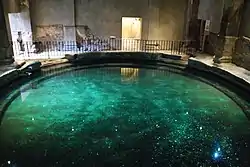Frigidarium
A frigidarium is a large cold pool at the Roman baths. When entering the bath house, one would go through the apodyterium, where they would store their clothes. After the caldarium and the tepidarium, which used hot water to open the pores of the skin, the frigidarium would be reached. The cold water would close the pores opened by the hot water. There would be a small pool of cold water or sometimes a large swimming pool (though this, differently from the piscina natatoria, was usually covered). The water could be also kept cold by using snow.

The frigidarium was usually located on the northern side of the baths. The largest examples of frigidarium were both in Rome: that of the Baths of Caracalla, located soon after the entrance, measures 58 x 24 m, and that of the Baths of Diocletian, covered by a groin vault. Some, like one in Pompeii, had a circular plan.
History
Individual standing hot water tubs were replaced by collective pools and the development of hypocaust heating. This led to various types of heated rooms including caldarium, tepidarium, laconicum/sudatorium, and the frigidarium.[1]
Baths of Trajan
The Baths of Trajan contained a double apse and were "paved with a remarkable mosaic representing the Triumph of Bacchus and the Dionysiac cycle." The mosaic is now at the Bardo National Museum in Tunis.[2]
See also
References
- Brill's New Pauly ARK-CAS. Boston: Leiden. 2003. p. 254.
- "The Princeton Encyclopedia of Classical Sites, ACHOLLA (Henchir Botria) Tunisia". www.perseus.tufts.edu. Retrieved 2018-04-05.
| Wikisource has the text of the 1911 Encyclopædia Britannica article Frigidarium. |
| Wikimedia Commons has media related to Frigidaria. |
- Frigidarium
- Baths of the Forum
- Pitts, M. 2006. Roman pool may be for early Christian baptism. British Archaeology 91: 8
